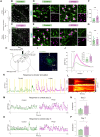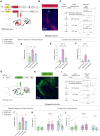Reversal of hyperactive higher-order thalamus attenuates defensiveness in a mouse model of PTSD
- PMID: 36735778
- PMCID: PMC9897664
- DOI: 10.1126/sciadv.ade5987
Reversal of hyperactive higher-order thalamus attenuates defensiveness in a mouse model of PTSD
Abstract
Posttraumatic stress disorder (PTSD) is a highly prevalent and debilitating psychiatric disease often accompanied by severe defensive behaviors, preventing individuals from integrating into society. However, the neural mechanisms of defensiveness in PTSD remain largely unknown. Here, we identified that the higher-order thalamus, the posteromedial complex of the thalamus (PoM), was overactivated in a mouse model of PTSD, and suppressing PoM activity alleviated excessive defensive behaviors. Moreover, we found that diminished thalamic inhibition derived from the thalamic reticular nucleus was the major cause of thalamic hyperactivity in PTSD mice. Overloaded thalamic innervation to the downstream cortical area, frontal association cortex, drove abnormal defensiveness. Overall, our study revealed that the malfunction of the higher-order thalamus mediates defensive behaviors and highlighted the thalamocortical circuit as a potential target for treating PTSD-related overreactivity symptoms.
Figures







References
-
- Tseng Y. T., Zhao B., Chen S., Ye J., Liu J., Liang L., Ding H., Schaefke B., Yang Q., Wang L., Wang F., Wang L., The subthalamic corticotropin-releasing hormone neurons mediate adaptive REM-sleep responses to threat. Neuron 110, 1223–1239.e8 (2022). - PubMed
MeSH terms
LinkOut - more resources
Full Text Sources
Medical
Molecular Biology Databases

